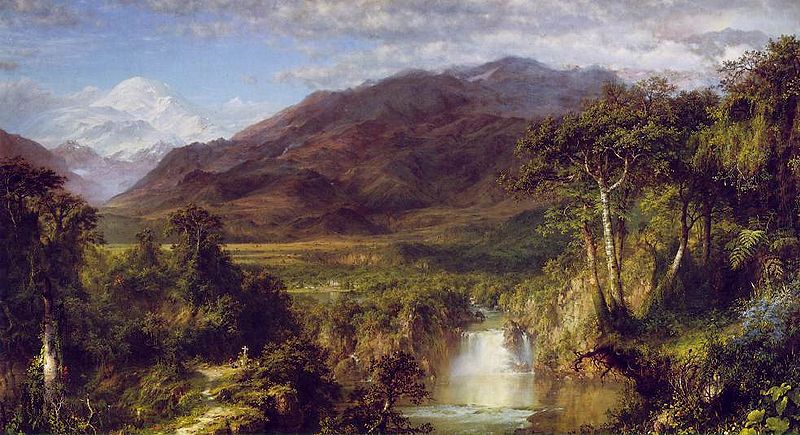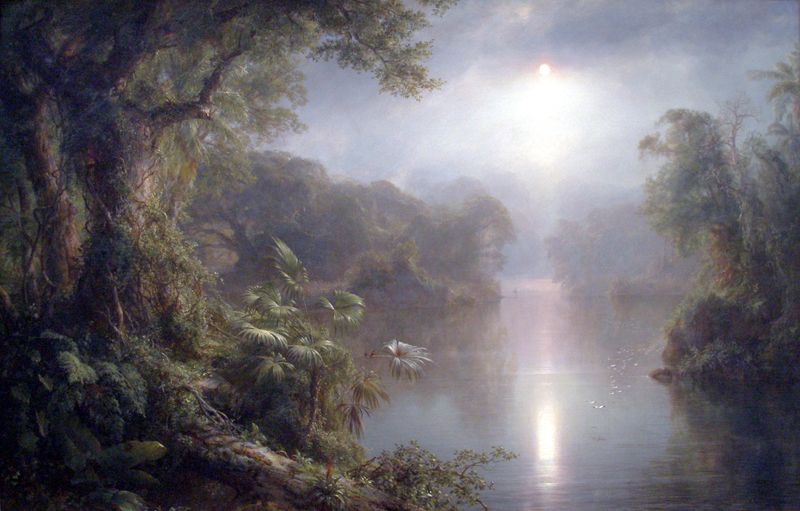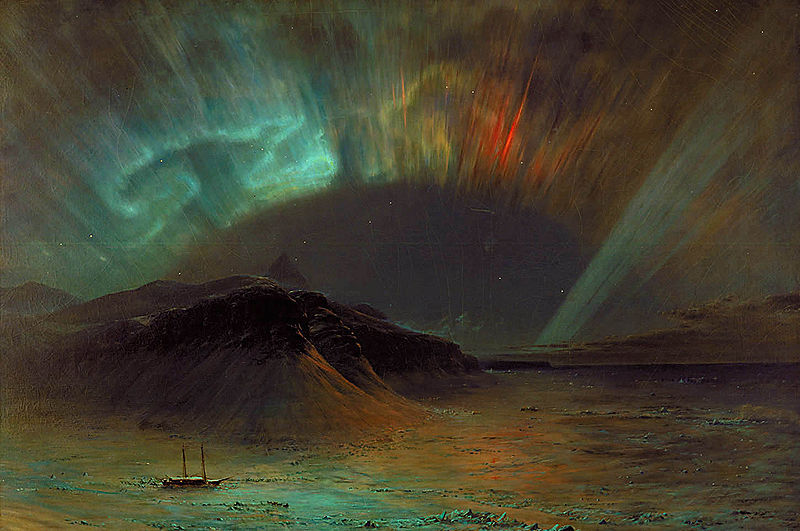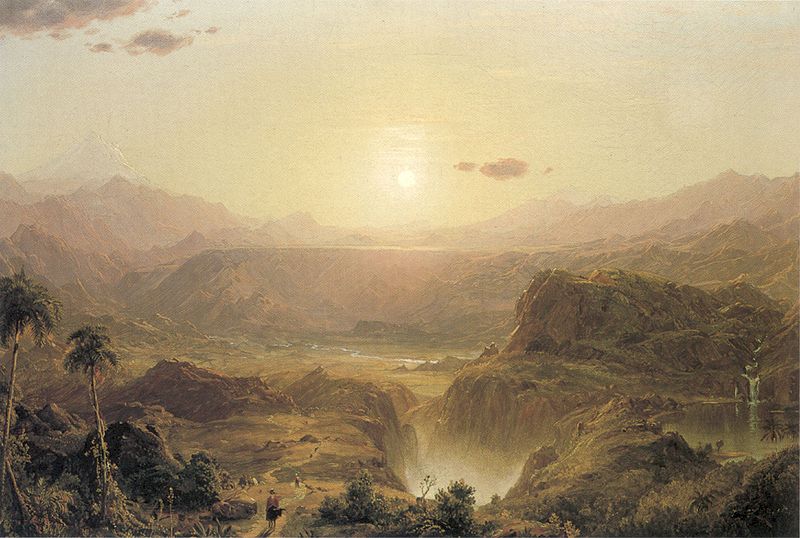<Back to Index>
- Biologist Thomas Henry Huxley, 1825
- Painter Frederic Edwin Church, 1826
- Prime Minister of Russia Alexander Fyodorovich Kerensky, 1881
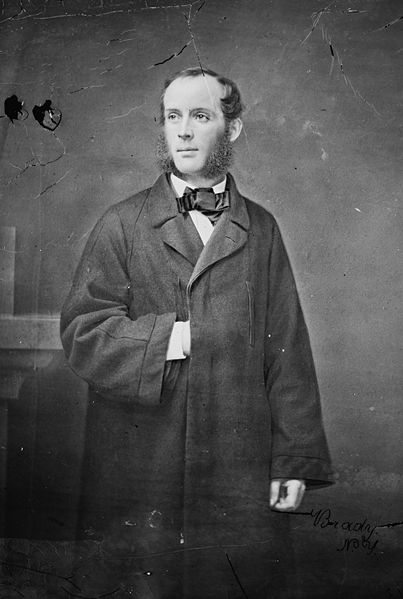
Frederic Edwin Church (May 4, 1826 – April 7, 1900) was an American landscape painter born in Hartford, Connecticut. He was a central figure in the Hudson River School of American landscape painters. While committed to the natural sciences, he was "always concerned with including a spiritual dimension in his works".
The family wealth came from Church's father, Joseph Church, a silversmith and watchmaker in Hartford, Connecticut. (Joseph subsequently also became an official and a director of The Aetna Life Insurance Company.) Joseph, in turn, was the son of Samuel Church, who founded the first paper mill in Lee, Massachusetts, in the Berkshires, and this allowed him (Frederic) to pursue his interest in art from a very early age. At eighteen years of age, Church became the pupil of Thomas Cole in Catskill, New York after Daniel Wadsworth, a family neighbor and founder of the Wadsworth Atheneum, introduced the two. In May 1848, Church was elected as the youngest Associate of the National Academy of Design and was promoted to Academician the following year. Soon after, he sold his first major work to Hartford's Wadsworth Atheneum. Church settled in New York where he taught his first pupil, William James Stillman. From the spring to autumn each year Church would travel, often by foot, sketching. He returned each winter to paint and to sell his work.
In 1853 and 1857, Church traveled in South America. One trip was financed by businessman Cyrus West Field,
who wished to use Church's paintings to lure investors to his South
American ventures. Church was inspired by the Prussian explorer Alexander von Humboldt's Cosmos and his exploration of the continent; Humboldt had challenged artists to portray the "physiognomy" of the Andes. Two years after returning to America, Church painted The Heart of the Andes (1859), now in the collection of the Metropolitan Museum of Art,
at the Tenth Street Studio in New York City. It is more than five feet
high and nearly ten feet in length (167.9 × 302.9 cm). Church
unveiled the painting to an astonished public in New York City in 1859.
The painting's frame had drawn curtains fitted to it, creating the
illusion of a view out a window. The audience sat on benches to view
the piece and Church strategically darkened the room, but spotlighted
the landscape painting. Church also brought plants from a past trip to
South America to heighten the viewers' experience. The public were
charged admission and provided with opera glasses to examine the
painting's details. The work was an instant success. Church eventually
sold it for $10,000, at that time the highest price ever paid for a
work by a living American artist. Church showed his paintings at the annual exhibitions of the National Academy of Design, the American Art Union, and at the Boston Art Club, alongside Thomas Cole, Asher Brown Durand, John F. Kensett, and Jasper F. Cropsey. Critics and collectors appreciated the new art of landscape on display, and its progenitors came to be called the Hudson River School. In 1860 Church bought a farm in Hudson, New York and married Isabel Carnes. Both Church's first son and daughter died in March, 1865 of diphtheria,
but he and his wife started a new family with the birth of Frederic
Joseph in 1866. When he and his wife had a family of four children,
they began to travel together. In 1867 they visited Europe and the Middle East, allowing Church to return to painting larger works. Before
leaving on that trip, Church purchased the eighteen acres (73,000
m²) on the hilltop above his Hudson farm—land he had long wanted
because of its magnificent views of the Hudson River and the Catskills.
In 1870 he began the construction of a Persian-inspired mansion on the
hilltop and the family moved into the home in the summer of 1872. Richard Morris Hunt was
the architect for Cosy Cottage at Olana, and was consulted early on in
the plans for the mansion, but after the Church's trip to Europe and
what is now Lebanon, Israel, Palestine, Syria, Jordan and Egypt, the
English architect Calvert Vaux was hired to complete the project.
Church was deeply involved in the process, even completing his own
architectural sketches for its design. This highly personal and
eclectic castle incorporated many of the design ideas that he had
acquired during his travels. Olana State Historic Site is
now owned and operated by the New York State Office of Parks,
Recreation and Historic Preservation, Taconic Region and receives
extensive support from The Olana Partnership, a private, non-profit
organization. The
main house is open to the public for guided tours. A visitor center
offers a film and panel exhibit as well as a Museum Shop, operated by
The Olana Partnership, offering books and many items inspired by the
exotic locales of Church’s travels and paintings. The grounds are open
year-round, 8am-sunset, for hiking, picnicking, snowshoeing or just
enjoying the view.
